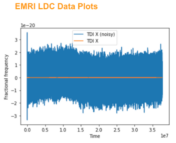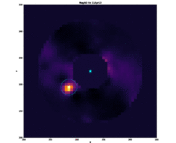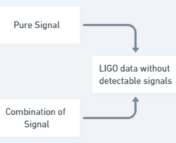The Undergraduate Research series is where we feature the research that you’re doing. If you are an undergraduate that took part in an REU or similar astro research project and would like to share this on Astrobites, please check out our submission page for more details. We would also love to hear about your more general research experience!
by Sebastian Banaszak
University of Wisconsin-Madison

Bio: I did this research as part of the CIERA REU program @ Northwestern University in summer 2023, before my senior year at UW-Madison. I enjoyed the program so much and can’t wait to continue working on this project until I can publish something!
What are Supermassive Black Hole Binaries?
Supermassive Black Holes (SMBHs) are titanic black holes which reside in the heart of almost every galaxy. They are between millions and billions times the mass of our Sun, they warp space and time, they generate enormous jets spanning several lightyears, and they influence their entire host galaxy’s evolution even though SMBHs are smaller compared to their host galaxies than a grain of rice is compared to the entire Earth!
When two galaxies meet, the gargantuan SMBHs at their centers begin a dance. Attracted to each other due to their great mass, they fall into a binary orbit, approaching each other until they orbit at a cosmically tiny 1 parsec (About 3 light years). This is a Supermassive Black Hole Binary (SMBHB).
Despite being some of the coolest objects in the universe, detecting these objects presents excellent opportunities to study black hole interactions, black hole-galaxy co-evolution and hierarchical galaxy formation (the theory that galaxies form and grow through repeated mergers). Furthermore, this research goes hand-in-hand with cutting edge Gravitational Wave (GW) research done by the Pulsar Timing Arrays (PTAs). The stochastic GW background, for which PTAs recently found evidence, is a symphony of cosmic GW sources, predicted to include SMBHBs. Using Pulsar Timing Arrays (PTAs), such sources may be detected and singled out using GW data, enabling us to perform multi-messenger astrophysics on SMBHBs—that is, combining gravitational wave and electromagnetic observations to observe a single source.
How do we detect them? (We can’t just take a picture!)
While these objects orbit at a distance of 1 parsec, they are at least several million parsecs away from us—some up to ~3 billion parsecs! So trying to resolve the two would be like looking up at the Moon and trying to distinguish two grains of sand 5 inches apart! To us, these objects just look like really bright point sources in the center of their host galaxies. As such, they would have been classified as regular quasars—the bright centers of galactic nuclei. Fortunately, we can use these objects’ colossal size and close orbit to our advantage. Using simple Newtonian gravity, we find SMBHBs would orbit each other at roughly ~5% the speed of light. At such high speeds, relativistic doppler boosting occurs: when moving at near-light speeds, approaching objects appear brighter and receding objects appear dimmer. So, if one of the orbiting SMBHs is bright enough, the SMBHB would appear periodically brighter and dimmer throughout the orbit. In other words, we would detect a periodic signal in the SMBHB’s light curve. Note: I will be referring to SMBHB light curves as quasar light curves, since SMBHB would still only be classified as quasars in current surveys.
The challenge of detecting this periodicity is that quasars themselves have stochastically (or randomly) variable brightness which may dominate the magnitude of periodic variation. So, our challenge becomes disentangling a smooth, consistent periodic signal from stochastic variability. We investigate 3 methods capable of performing this disentanglement—a nested Bayesian sampler, generalized Lomb Scargle periodogram (GLS), and the weighted wavelet Z-transform (WWZ). Each of the 3 methods return estimations of the periodic signal parameters (amplitude, period, phase) and a measure of the significance of the periodic variation (i.e., what is the “likelihood” the detected periodic signal was not just typical stochastic variability “acting like” a periodic signal). Overall, the nested Bayesian sampler outperforms the other two methods for objects with low amp/sigma (approximation for signal/noise ratio), but we investigate this recovery for different light curve characteristics in which the other two methods prove their worth.
In the future, we look to use the best combination of these methods which will most accurately assess and classify quasar light curves—it may become clear that one method is the best, but we’re hard at work testing all of the possibilities. We will publish our results and conclusions in a paper soon!
Astrobite edited by: Huei Sears
Featured Image Credit: NASA’s Goddard Space Flight Center/Scott Noble; simulation data, d’Ascoli et al. 2018





Note that SMBHB with parsec scale orbits will have periods of tens of thousands of years and negligible gravitational wave emissions. The binaries we would really like to find would have periods of ~1 to ~10 years and orbits comparable in size to the solar system; these are the ones we think dominate the PTA stochastic gravitational wave background.